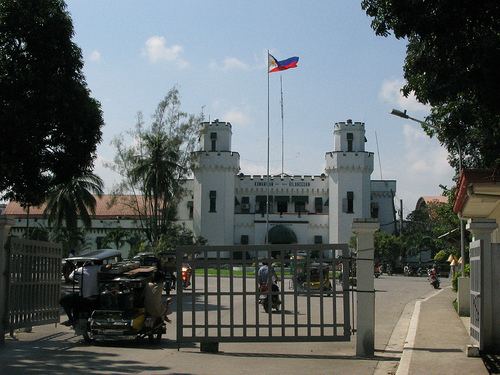 | ||
Agency executive Ricardo Rainier G. Cruz III, Director Website | ||
The Bureau of Corrections (Filipino: Kawanihan ng mga Bilangguan, literally "Bureau of Prisons", which was the old name of the agency from 1905 to 1989; abbreviated BuCor) is an agency of the Department of Justice which is charged with the custody and rehabilitation of national offenders, who have been sentenced to three years of imprisonment or more. The agency has its headquarters in the New Bilibid Prison Reservation in Muntinlupa City.
Contents
Organization
It is headed by Director General Ricardo Rainier G. Cruz III (which will be replaced by Philippine Marines major general Alexander Balutan by August 1, 2016) and the bureau has 2,862 employees, 61% of whom are custodial officers, 33% are administrative personnel and 6% are members of the medical staff.
Mission
To maximize the assets' value of the BuCor to effectively pursue its responsibility in safely securing transforming national prisoners through responsive rehabilitation programs managed by professional Correctional Officers.
Mandate
The Principal task of the Bureau of Corrections is the rehabilitation of National Prisoners.
Units
The Bureau of Corrections currently have 7 operating units located nationwide:
Spanish Rule
The Old Bilibid Prison which was located on Oroquieta Street in Manila was established in 1847 and by a Royal Decree formally opened on April 10, 1866. On August 21, 1870 the San Ramon Prison and Penal Farm was established in Zamboanga City for Muslim and political prisoners opposed to the rule of Spain.
American Colony
the Iuhit penal Settlement now known as Iwahig Prison and Penal Farm was established in 1904 by the Americans in 28,072 hectares of land. The land areas expanded to 40,000 hectares in the late 1950s. and expanded again to 41,007 hectares by virtue of Executive Order No. 67 issued by Governor Newton Gilbert on October 15, 1912.
The Bureau of Prisons was created under the Reorganization Act of 1905 as an agency under the Department of Commerce and Police. The Reorganization Act also re-established the San Ramon Prison in 1907 which was destroyed during the Spanish–American War in 1888. The prison was placed under the Bureau of Prisons and receive prisoners in Mindanao.
The Correctional Institution for Women was founded on November 27, 1929 by virtue of Act No. 3579 as the first and only prison for women in the Philippines. Later, on January 21, 1932, the bureau opened the Davao Penal Colony in Southern Mindanao.
The New Bilibid Prison was established in 1935 in Mutinlupa due to the increased rate of prisoners.
Proclamation No. 72 issued on September 26, 1954, established the Sablayan Prison and Penal Farm in Occidental Mindoro, and the Leyte Regional Prison was established on January 16, 1973, under Proclamation No. 1101.
New Name
The Administrative Code of 1987 and Proclamation No. 495, issued on November 22, 1989, changed the agency's name to the current Bureau of Corrections from Bureau of Prisons.
Logo
The logo presented here, is symbolic of the Bureau's mandate, the rehabilitation of inmate. The logo focuses on the man in prison as the main concern of rehabilitation. It presents man behind bars, but who looks outwards with the hope of rejoining the free community. The rays of the sun and the color green are symbolic of hope. The color orange is symbolic of happiness. The bar of justice represents the justice system. (jrcp)
